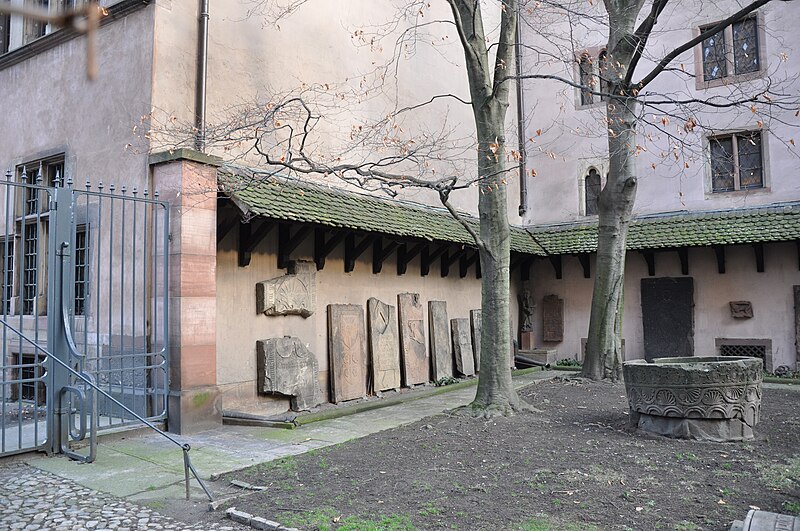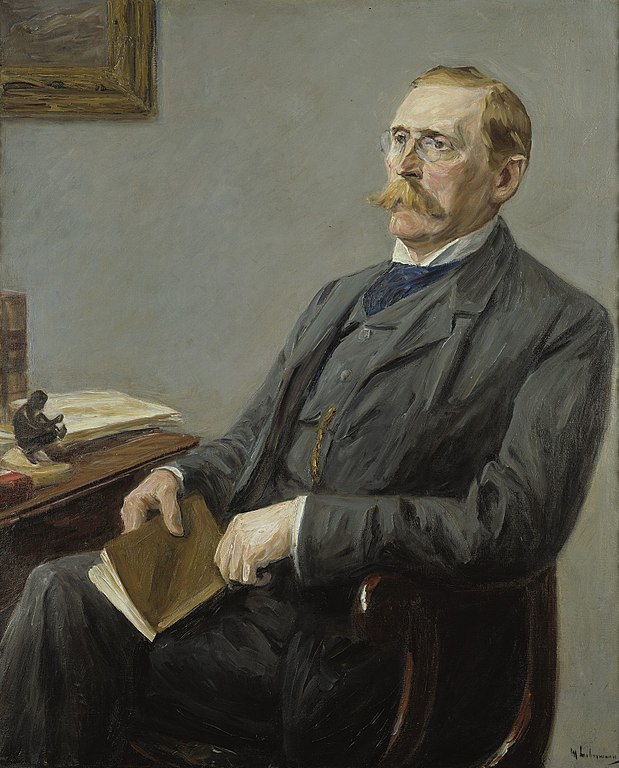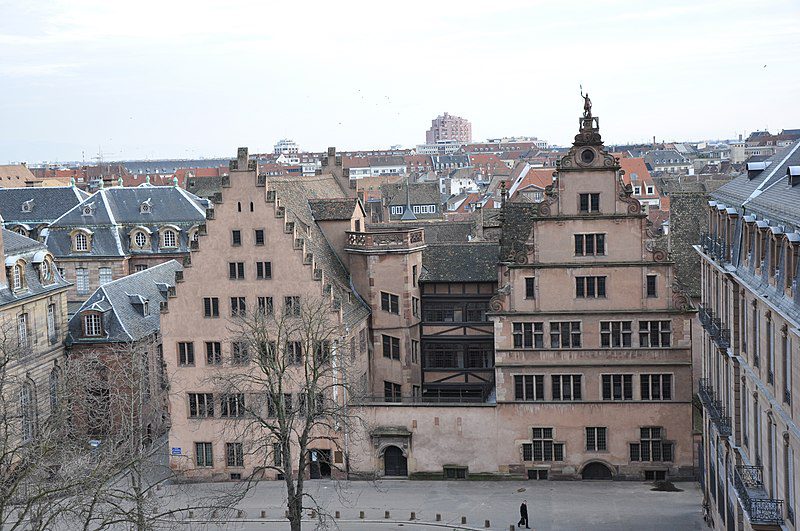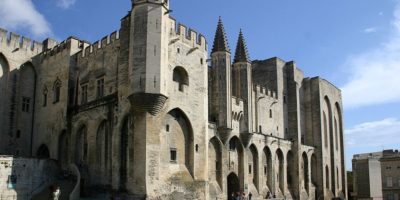
Image by Ji-Elle from Wikimedia
Top 10 Interesting Facts about Musee De L’oeuvre Notre-dame
An interesting thing about the cathedral, L’ouvre-Notre-Dame museum is that it is dedicated to Alsace art from the Middle Ages and the Renaissance. Domiciled in a group of old houses set in small courtyards, it contains most of the cathedral’s original statues, Wissembourg’s famous head of Christ which is one of the oldest figurative stained-glass windows in the world, together with some splendid paintings, outstanding architectural drawings, still lifes, glassware and furniture.
The museum was created between 1931 and 1939 by Hans Haug, director of the museums of Strasbourg. It offers a memory of the evolution of the arts in Strasbourg and in the region of Upper Rhine between the 11th and 17th century.
Its aptly set in Gothic, Renaissance and 17th century buildings, the core of which is the Maison de L’ouvre Notre-Dame, the seat since the 13th century of the institution in charge of the administration of the site and the Strasbourg Cathedral. Here are the top 10 interesting facts about Musee De L’oeuvre Notre dame.
1. Musée de L’oeuvre Notre-dame was Built to Merge Rhenish Artworks

Image by Jean-pierre Dalbera from Wikimedia
The Musée de l’ouvre Notre-Dame was created in order to merge, under a single roof, four thematically related but differently focussed, collections of Upper Rhenish art created prior to 1681. It is located in the half-Gothic, half-Renaissance building of the Fondation de L’ouvre Notre-Dame and also in several early Baroque timber-framed houses which surround it.
Finally, in the new museum of decorative arts of the city, the “Hohenlohe Museum”, works of decorative art from the Middle Ages, Renaissance and Early Baroque were also exhibited. These collections, which had been housed in various locations, were united in 1931 in the newly founded Musée de L’ouvre Notre-Dame.
The museum includes some of the finest masterpieces of medieval sculpture, obtained from the cathedral among others. Visitors can also admire a number of major works of 15th century Rhenish art (Conrad Witz and Nicolas de Leyde).
2. Musée de L’oeuvre Notre-dame Stoskopff’s still lifes

Image by Musée des Beaux-Arts de Strasbourg from Wikimedia
The exhibition rooms devoted to the Renaissance and the 17th century include decorative items produced in Strasbourg and an outstanding collection of still lifes by Sebastien Stoskopff.
Sébastien Stoskopff painted this 1644 still life towards the end of his career, three or four years after returning to his native Strasbourg. Born in that free city of the Empire in 1597, he began his apprenticeship with a local painter named Friedrich Brentel before his father, an official courier, managed to obtain a grant for him in 1615 to study with Daniel Soreau in Hanau.
Stoskopff fell into oblivion and was not rediscovered until the second half of the 19th century, when Hans Haug, Director of the Musée de L’oeuvre Notre Dame, added several of Stoskopff’s still lifes to Strasbourg’s collections. Today there are nine of them.
3. Heritage meets Innovation at Musée de L’oeuvre Notre-dame
In order to give visitors a new way to discover its collections, the L’ouvre Notre-Dame Museum offers an original experience using digital media. 18 artworks or sets of artworks are revealed and experienced with all the possibilities offered by digital technologies.
The tour, called “The L’ouvre Notre-Dame Goes Digital”, recreates the artworks in their original environments or uses virtual reality to show their initial appearance. It’s an opportunity to gain a deeper insight into these statues, sculptures and paintings that have journeyed through the centuries!
Thanks to holograms, statues that are missing some parts can be seen in their entirety. You can also put statues back into their original context (the octagon of the cathedral), thanks to video projection, or explore the architecture of the buildings, with virtual immersion.
4. The Museum holds the Oldest Figurative Stained Glass in Europe

Image by Ji-Elle from Wikimedia
The collection of the L’ouvre Notre-Dame Museum is of inestimable value. Amongst other things, you’ll see a stained glass window called “The Wissembourg Christ”, the oldest intact figurative stained glass window in France.
Since early Christianity, Jesus’ race and appearance have been a huge source of public debate and in that time span, His image has been depicted in a multitude of ways. A glass image of Jesus, known as the Head of Christ is one of the oldest pieces of stained glass in the world, dating between 1040 and 1056 AD. This work of art is held in Le Musee de l’Oeuvre Notre-Dame in Strasbourg, France.
5. Musée de L’oeuvre Notre-dame is Supported by an Alsace focused Conservation Society

Image by M.Strikis from Wikimedia
The originals of the sculptures were removed or knocked down during the French Revolution and were later replaced by copies. The Société pour la conservation des monuments historiques d’Alsace (Society for the Conservation of the Historical Monuments of Alsace), endeavours to rescue the most valuable components and decorations (altars, statues, vessels, tapestries) from churches, cloisters and chapels which had been abandoned to destruction or decay throughout Alsace.
Supported by the State – Ministry of Culture, the Grand Est region and the departments of Bas-Rhin and Haut-Rhin, aims to pool resources, Skills and financial resources to ensure better coherence of conservation and dissemination policies for regional archaeological collections.
6. Wilhelm von Bode helped restore Musée de L’oeuvre Notre-dame Painting Collection

Image byMax Liebermann from Wikimedia
The painting collection of the city, restored by Wilhelm von Bode around 1890, exhibited a primary focus on regional masters, as noted by the donation of the “Portrait of the canon Ambrosius Volmar Keller”, a masterpiece of Hans Baldung from the private collection of Wilhelm II.
In the 1890s Berlin was far behind Munich and Dresden in its art collections, but with the enthusiastic participation of Wilhelm II, Bode was able to shift the center of the German art world to the capital. He was also in charge of rebuilding the museums of Strasbourg, whose collections had been entirely destroyed in 1870 by Prussian bombardments during the Franco-Prussian War.
Bode occupied this post from 1889 to 1914, establishing the Musée des Beaux-Arts and the Cabinet des estampes et des dessins as well as setting the grounds of part of the current Musée de L’oeuvre Notre-Dame’s collections.
7. Some of the Musée de L’oeuvre Notre-dame Statutes are not the Originals

Image by Jean-Pierre Dalbera from Wikimedia
Most of the statues on the sides of the cathedral aren’t the originals. Le Musée de l’Oeuvre Notre-Dame has a special group whose task is to recreate all the statues and replace them to conserve the originals and place them in the museum.
The first rooms contain some of the original statues from the cathedral, now preserved. Most were removed and replaced early in the 20th century, to protect them from pollution. It is wonderful to be able to admire the sculptures up close since many of them are high up on the cathedral walls and hard to appreciate fully from a distance. The Ecclesia and Synagoga statues, sculpted in the 13th century are especially moving.
Did you know that, in the beginning, the statues at the cathedral were painted? … to find out more visit the museum.
8. Musée de L’oeuvre Notre-dame Timeless Stonemasons Guild Room
This large square room decorated with frescoes and ornamental woodwork is located on the ground floor of the west wing of the Cathedral Fabric building. It was most likely the meeting room of the cathedral stonemason’s guild, which was active in the Middle Ages. It was only in 1931, when the museum was founded, that this room got its official name as the “Lodge Room”.
The Cathedral Fabric Fund is a foundation that dates from the Middle Ages and was responsible for the construction of the Cathedral of Strasbourg. It was created to supervise the work on site. Since the 14th century, it had incorporated all the stonemasons working on the cathedral site, who later founded an independent guild from the one which was made up of the other stonemasons employed by the city.
In fact, so important was the Strasbourg Lodge that in 1456 it became the supreme lodge of all stonemasons’ guilds of the Holy Roman Empire. Having Survived the French Revolution, it has been supervising the maintenance of the cathedral ever since.
9. Musée de L’oeuvre Notre-dame Gardens Gothic Gardens

Botanical garden of Musée de l’Oeuvre Notre-Dame. Image by Ji-Elle from Wikimedia
Inspired by medieval traditions, this small garden (1937) is home to a collection of very old plants taking the form of 9 squares: household plants and spices.
The double-winged building, complemented by a gothic garden, served for a long time as the administrative headquarters of the building lodge. The interior design, cool courtyards and charming Gothic garden lend a feeling of intimacy to Strasbourg’s past.
10. Musée de L’oeuvre Notre-dame is located in Region not Germany, but not quite France

Image by Mister No from Wikimedia
The name Alsace can be traced to the Old High German Ali-saz or Elisaz, meaning “foreign domain”. An alternative explanation is from a Germanic Ell-sass, meaning “seated on the Ill”, a river in Alsace.
Even though Alsace is part of France, it is sometimes perceived as a cultural exception, in part due to its long periods spent under German influence. In 1871, Alsace was annexed to the new German Empire following its victory in the Franco-Prussian War.
Alsace is a historical region in northeastern France on the Rhine River plain. Bordering Germany and Switzerland, it has alternated between German and French control over the centuries and reflects a mix of those cultures. Its capital, Strasbourg, is centred on the Ill River’s Grand Île island, bordered by canals and home to the Gothic Cathédrale Notre-Dame de Strasbourg,
The museum is a lush collection of art from over seven centuries, displayed in beautiful old buildings. It is more than an art museum. Here you’ll learn the history of the city in relation to the cathedral so as to better understand Strasbourg.
Practical Infomation
Address: 3 Pl. du Château, 67000 Strasbourg, France
Phone No: +33 3 68 98 50 00
Open every day except Mondays and January 1, Good Friday, May 1, November 1 and 11, December 25
Planning a trip to Paris ? Get ready !
These are Amazon’s best-selling travel products that you may need for coming to Paris.
Bookstore
- The best travel book : Rick Steves – Paris 2023 – Learn more here
- Fodor’s Paris 2024 – Learn more here
Travel Gear
- Venture Pal Lightweight Backpack – Learn more here
- Samsonite Winfield 2 28″ Luggage – Learn more here
- Swig Savvy’s Stainless Steel Insulated Water Bottle – Learn more here
Check Amazon’s best-seller list for the most popular travel accessories. We sometimes read this list just to find out what new travel products people are buying.











